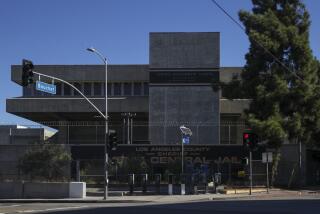Utah Capitol to Get the Shock Treatment
- Share via
SALT LAKE CITY — The Utah Capitol could be riding the next big earthquake like a ship at sea after engineers hoist the 67,500-ton marble building and drop it on a set of shock absorbers.
They can only hope to get it done in time.
Salt Lake is due for a major earthquake that could knock the Capitol dome off its precarious perch, snap marble columns and collapse upper floors. For a 59-member team of architects, engineers, construction and historic preservation managers, shoring up the four-story Capitol is a race against time.
The digging will start in December 2004, and the work will last four years.
“If people can walk out alive, that’s the objective we’re after,” says Jerod Johnson, a structural engineer for Salt Lake’s Reaveley firm, among 14 companies that have a piece of the Capitol’s $200-million restoration.
Together with Forell/Elsesser Engineers of San Francisco, the Reaveley group has the delicate task of hydraulically lifting the entire Capitol, a marble-and-concrete statehouse built with almost no reinforcing steel.
Engineers have a word for it: brittle.
The firms also are designing a set of internal walls that will let the Capitol sway at the foundation while keeping its upper half from snapping off.
Utah’s Capitol is doomed without a suspension system, engineers say. Although strong Utah earthquakes are infrequent, separated by hundreds of years, the record shows them to be fairly regular -- and particularly violent. In an instant they could raise the Wasatch mountains 10 feet and drop the valley by 5, ripping open the land like a zipper. Such a quake would cause widespread damage to older buildings and homes made of unreinforced brick, and snap water and gas lines.
The clock is different for each of dozens of active bedrock faults ensnaring Utah’s heavily populated Wasatch corridor. But by some measures the kind of 7.3-magnitude earthquake that the Capitol will be designed to withstand is a century overdue. More distant quakes could collapse the building, as could smaller quakes nearby.
“We’re expecting the next earthquake to hit anytime between now and 25 years from now,” says David Hart, executive director for the Capitol Preservation Board.
Statehouse occupants -- including Gov. Mike Leavitt and a part-time Legislature -- can only hope to get out in time.
“The Big One is of a lot of interest,” said Gary Christenson of the Utah Geological Survey. “We don’t like to use the word overdue, but it could occur anytime.”
The Capitol could reopen for business as soon as January 2008. Lawmakers will work in a pair of $45-million office wings being built by Salt Lake’s Jacobsen Construction Inc., lead contractor for the Capitol restoration.
The odds of a major quake have the Capitol Preservation Board kick-starting the Capitol project on a $10-million advance from the Legislature. The retrofit is so complex that lawmakers had to consider tearing down their 89-year-old Capitol and starting over.
But engineers said it could be reliably fixed for about $200 million, including renovations.
Estimates for a new Capitol, matching every Gothic detail, ran to $800 million, and rebuilding wasn’t going to be easy. The Georgia mill that originally carved Utah’s 30-foot solid-marble columns wrecked the only machinery capable of shaping the columns.
That and other logistical challenges forced officials to think renovation instead of rebuilding.
The engineers are shopping for a set of base isolators, which are rubber-and-steel mounts about four feet wide. They plan to use 280 of the mounts to support a steel and concrete grid holding up the Capitol -- a new chassis that will let the building pitch and slide two feet in any direction.
In an earthquake the ground would abruptly move first, then the Capitol would slowly catch up, swaying this way and that. It still would be likely to rain debris, chasing occupants under their desks.
The quake would last only 30 seconds, but it probably would come without warning. On the Wasatch bench where the Capitol sits, the shaking would be more violent than on the basin floor, where unconsolidated soils could liquefy, proving that no area would be considered safe.
“In my view we’re all in this crapshoot together,” says Walter Arabasz, research professor and director of the University of Utah’s Seismograph Stations.
More to Read
Sign up for Essential California
The most important California stories and recommendations in your inbox every morning.
You may occasionally receive promotional content from the Los Angeles Times.













